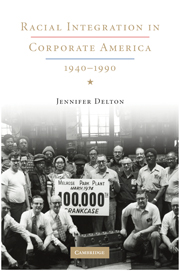Book contents
- Frontmatter
- Contents
- List of Tables
- Introduction
- PART I COLOR-BLIND GROUNDWORK, 1940–1961
- 1 The African American Struggle for Jobs
- 2 Fair Employment Is Good Business
- 3 Racial Liberalism and the Mid-Twentieth-Century Businessman
- 4 Human Relations in Management
- 5 Human Relations at International Harvester and Pitney-Bowes
- PART II COLOR-CONSCIOUS ASCENDANCY, 1961–1990
- Epilogue: From Affirmative Action to Diversity
- Statistical Tables
- Bibliography
- Acknowledgments
- Index
- References
2 - Fair Employment Is Good Business
Published online by Cambridge University Press: 05 June 2012
- Frontmatter
- Contents
- List of Tables
- Introduction
- PART I COLOR-BLIND GROUNDWORK, 1940–1961
- 1 The African American Struggle for Jobs
- 2 Fair Employment Is Good Business
- 3 Racial Liberalism and the Mid-Twentieth-Century Businessman
- 4 Human Relations in Management
- 5 Human Relations at International Harvester and Pitney-Bowes
- PART II COLOR-CONSCIOUS ASCENDANCY, 1961–1990
- Epilogue: From Affirmative Action to Diversity
- Statistical Tables
- Bibliography
- Acknowledgments
- Index
- References
Summary
Businessmen generally want to do the right thing for their workers just because it is right, but if they say it as simply as that, they think it makes them sound naïve. So they feel they have to rationalize any decent move they make as a plan for increasing productivity and profits.
Walter Wheeler, President of Pitney-Bowes, Inc.If inequities and frictions arising from discrimination in the employment relationship are permitted to continue, they will not only interfere with the development of harmonious industrial relations, but will invite government legislation.
National Association of Manufacturers, memo, 1948There were many reasons employers might hire black workers into white positions before the Civil Rights Act of 1964. The most common were labor shortages, state or municipal fair employment laws, defense contract requirements, pressure from civil rights organizations, and moral (or religious) considerations. But those business leaders who were most enthusiastic about promoting fair employment in the post–World War II decades rarely mentioned these. Instead, echoing fair employment activists, they emphasized how fair employment was “good business.” Variations on the phrase “fair employment is good business” appeared in just about every account of fair employment from World War II through the 1970s. Originally a slogan, it turned up repeatedly in articles, books, and pamphlets. Some time in the mid-1950s, it became “merit employment is good business” and then “equal opportunity is good business.” The phrase persisted because businessmen really wanted to believe that the free market fostered equal opportunity for all.
- Type
- Chapter
- Information
- Racial Integration in Corporate America, 1940–1990 , pp. 42 - 71Publisher: Cambridge University PressPrint publication year: 2009



